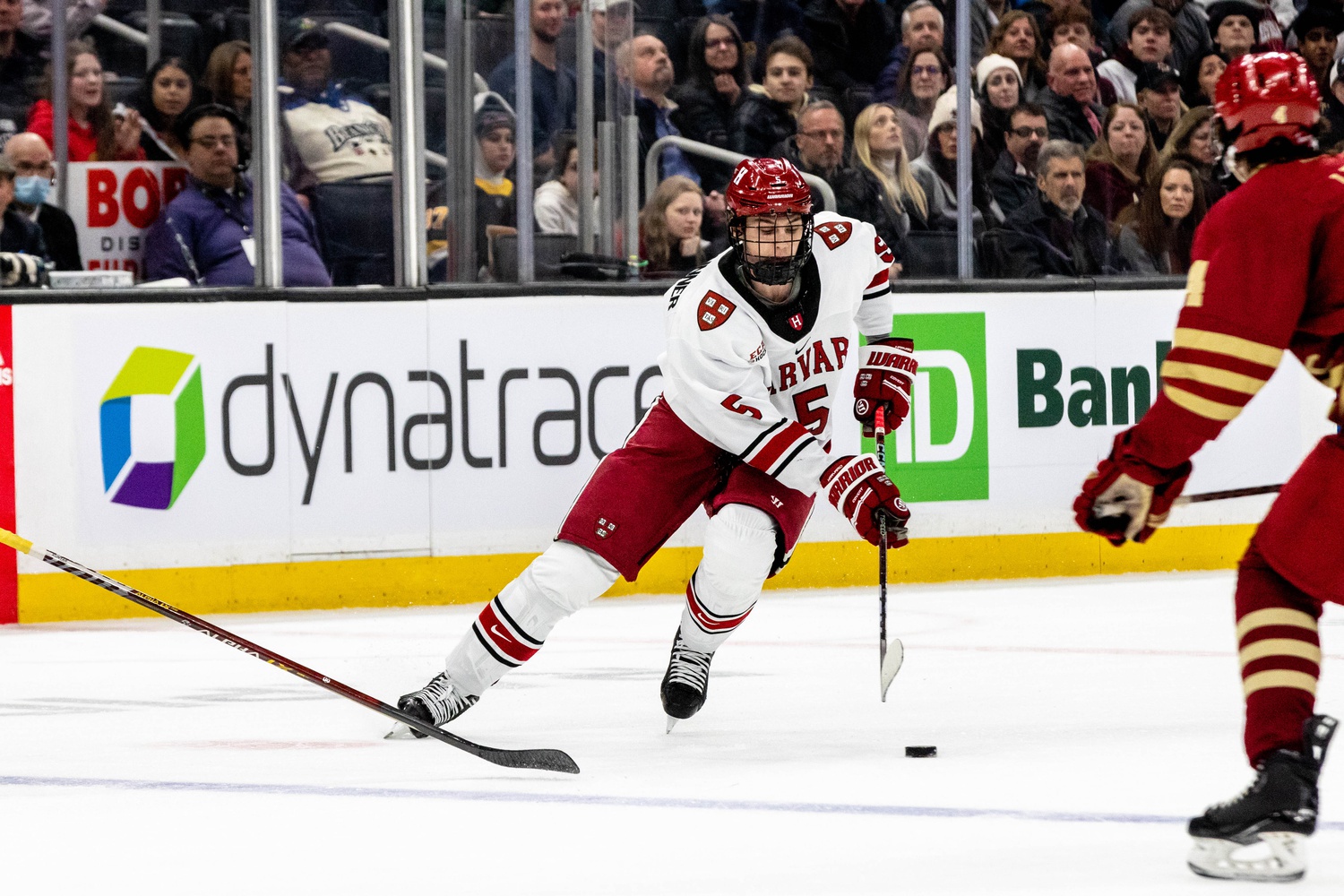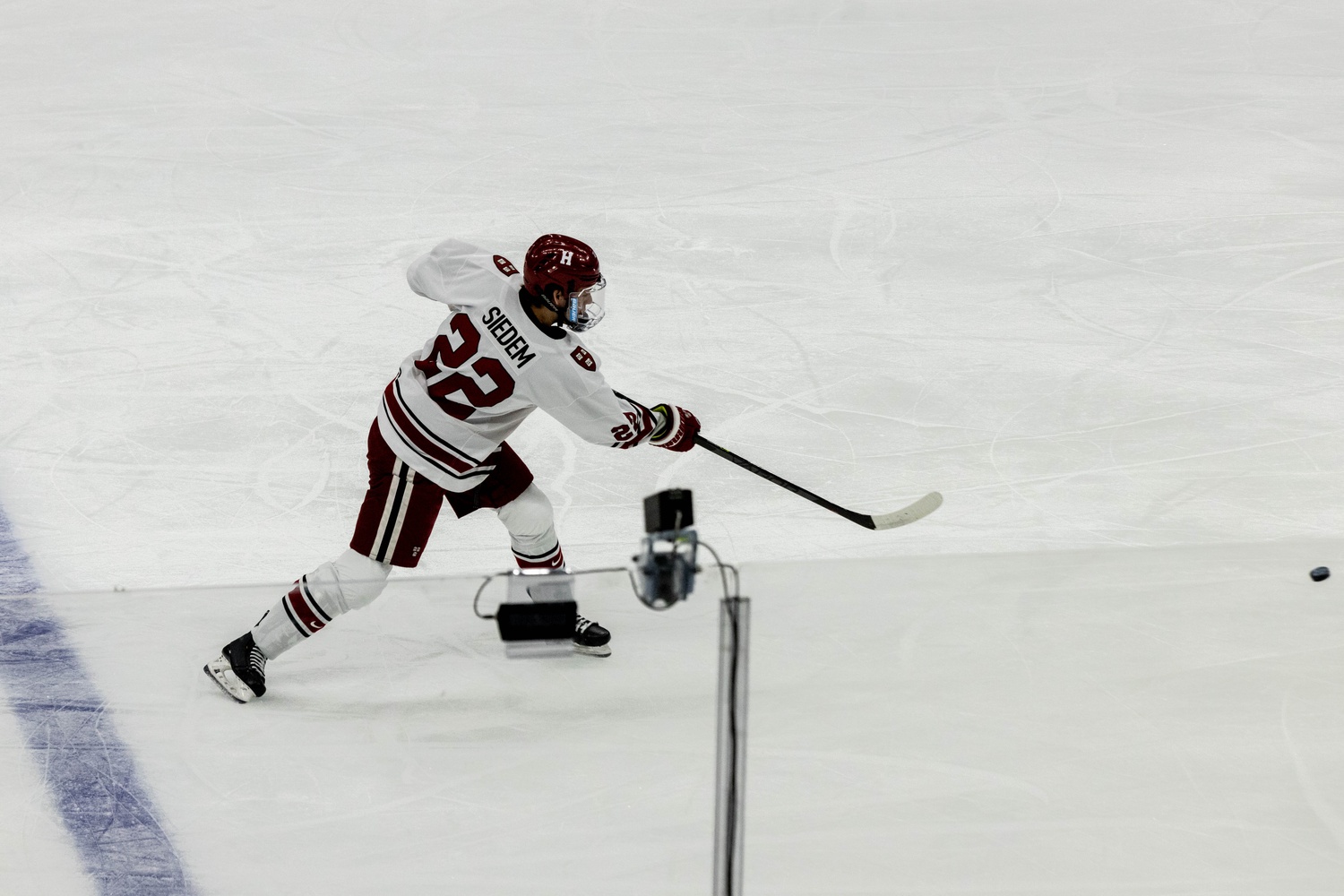
News
Summers Will Not Finish Semester of Teaching as Harvard Investigates Epstein Ties

News
Harvard College Students Report Favoring Divestment from Israel in HUA Survey

News
‘He Should Resign’: Harvard Undergrads Take Hard Line Against Summers Over Epstein Scandal

News
Harvard To Launch New Investigation Into Epstein’s Ties to Summers, Other University Affiliates

News
Harvard Students To Vote on Divestment From Israel in Inaugural HUA Election Survey
No. 7 Harvard Men’s Ice Hockey to Face No. 8 Ohio State in NCAA Tournament Opener

All roads have led to this.
After its best regular season campaign since 2016-2017, the No. 7 Harvard men’s ice hockey team will look to kickstart a championship run against the No. 8 Ohio State Buckeyes on Friday afternoon in Bridgeport, Conn.
Behind the bench, the Crimson is steered by Ted Donato ’91, who will make his eighth NCAA tournament appearance in his 19th season as head coach. On the ice, Harvard is captained by three seniors: defenseman Henry Thrun, forward Baker Shore, and forward John Farinacci. Farinacci missed the first half of the season due to injury before returning in January.
“We certainly start the year out with goals and hopes and expectations,” said Donato at the end of the regular season. “We know everybody starts on even footing in the playoffs, and it's always difficult to try to end somebody's season and move on. It's something that we've talked a lot about throughout the year – trying to get ourselves to a point where we could play our best when it mattered the most.”
At forward, the Crimson’s top six is loaded with star power. Junior Sean Farrell, the ECAC Player of the Year, led the team with 52 points (20 goals, 32 assists) on his way to being named a Hobey Baker Award top-10 finalist. Farrell’s linemate, sophomore Matthew Coronato, tallied 20 goals of his own en route to a spot on the All-ECAC Second Team. Junior Alex Laferriere joined Coronato on the Second Team after leading the team with 21 goals, while first-year Joe Miller earned a unanimous spot on the ECAC All-Rookie Team with 28 points (13 goals, 15 assists).
On defense, Harvard is backstopped by Thrun, who won the ECAC Howies Hockey Best Defensive Defenseman Award. First-year Ryan Healey earned a spot alongside Miller on the All-Rookie team, and senior Ryan Siedem and sophomores Ian Moore and Jack Bar provided a steady presence in the top four. In net, senior Mitchell Gibson turned in the finest season of his career, posting career-best marks in goals-against average and save percentage and winning a spot on the All-ECAC Second Team.
“We're definitely a pretty offensive team, but I think we know the kind of style we need to play to win big games,” said Laferriere at the end of the regular season.
Despite the Crimson’s infrequent competition against the Big Ten Conference, the squad still has some familiarity with the Buckeyes, both through recruiting and competition in the USHL, the United States’ top junior hockey league. Ohio State’s attack is led by freshman Stephen Halliday, a draft pick of the NHL’s Ottawa Senators and USHL alum, who tallied 40 points (nine goals, 31 assists) on the season. Halliday and goaltender Jakub Dobes were All-Big Ten honorable mentions, while forwards Jake Wise and Mason Lohrei, the squad’s second and third leading scorers, respectively, were named to the All-Big Ten Second Team.
“There are a lot of their players that we have some familiarity with as far as recruiting goes and watching other college games during the season…but certainly not a team that we are familiar with from a style standpoint,” Donato said. “That's something that we'll get on the video and on the phone and figure out what makes them successful.”
Ohio State’s game pounds opposing goalies with shots, as the Buckeyes average over 36 shots on goal per game while conceding under 29 per game. Ohio State’s penalty kill is the best unit in the country, shutting down opposing power plays at an eye-popping 89.5% clip. However, the Buckeyes are also one of the weakest faceoff teams in the nation, with their faceoff win percentage of 47.8% ranking 44th out of 60 teams.
Ohio State began the season with two-game sweeps of Mercyhurst and Wisconsin before getting blown out 6-1 by UConn on Oct. 15. The Buckeyes responded with a sweep of Bentley before splitting a two-game set with the University of Minnesota, the NCAA Tournament’s top overall seed. After a stretch of four losses in five games, the team got back into top form with a road victory over Penn State on Dec. 3, kicking off a run of six straight wins that culminated in a victory over the Michigan Wolverines, the tournament’s second overall seed. The Buckeyes ended their regular season with a sweep at the hands of Minnesota, but they rebounded to advance to the Big Ten Tournament semifinal, where they lost 7-3 to the Wolverines.

The Crimson began the season with seven consecutive wins, including six over ECAC competition. The stretch matched the program’s best start to a season since 1989, when Harvard won its only national championship. In a trend that defined the Crimson’s campaign, the squad overcame deficits in three of its early wins, rebounding from slow starts to top Dartmouth, Princeton, and RPI.
After a perfect 7-0-0 start on the East Coast, Harvard headed to the midwest for a two-game set against then-No. 5 Michigan, an out-of-conference foe loaded with NHL-caliber talent. After battling to a 4-4 draw in the first game, the Crimson suffered its first defeat of the season the next night, falling 4-1 to the Wolverines despite putting up 40 shots on goal. However, Harvard responded to the defeat less than a week later, claiming a 2-1 overtime victory on the road at Cornell’s Lynah Rink, with ECAC Player of the Year Sean Farrell scoring the game-winner. The next night, the Crimson were stymied by Colgate goaltender Carter Gylander, whose 36 saves preserved a 6-4 victory for the Raiders, sending Harvard into the midseason break with a record of 8-2-1.
“It’s a pretty resilient group,” Donato said. “We've won some games in overtime, we've had some comebacks, we've had some injuries throughout the year, so we've had all sorts of people step up under those conditions.”
The Crimson returned to play on Dec. 30 at Boston University’s Walter Brown Arena for a top-10 showdown with the Terriers. In a goaltending duel between Gibson and BU Olympian Drew Commesso, the Terriers emerged with a 2-1 overtime victory after a goal from captain Domenick Fensore. The Crimson responded again with a strong victory, throttling Northeastern 8-4 at home on New Year’s Day. The next weekend, Harvard’s habit of slow starts and lead-chasing reared its head again. Despite erasing a three-goal third period deficit in an overtime victory over Princeton, the Crimson couldn’t pull off the same trick the next night in a 4-1 loss to No. 2 Quinnipiac, as the Bobcats’ impenetrable defensive structure and goaltending suffocated the Harvard offense.
After a 5-1 mid-January stretch against ECAC competition, including a thrilling 3-2 overtime victory over Yale and a 5-4 comeback win in overtime against Colgate, the Crimson got another shot at the ECAC-leading Bobcats on Feb. 3, but Quinnipiac emerged victorious yet again. Star goaltender Yaniv Perets, the ECAC Goaltender of the Year and a top-10 finalist for the Hobey Baker Award, posted a 25-save shutout, while Harvard’s potent power play was shut out on its three chances in the 3-0 loss.
Despite the loss to the Bobcats, the Crimson entered February’s Beanpot Tournament with an excellent opportunity to secure its first trophy in six years. In its semifinal bout with the Boston College Eagles, Harvard got out to a 2-0 start and held a 3-1 lead late in the third period before Eagles forwards Nikita Nesterenko and Cutter Gauthier scored in the final five minutes to send the game to overtime. Despite being outshot 22-2 in the final period, the Crimson regrouped, and in the dying seconds of the three-on-three extra session, first-year forward Marek Hejduk hammered home the game-winner on his first overtime shift of the season, sending Harvard to the championship game.
In a tight and emotional Beanpot title game, the Crimson and the Northeastern Huskies fought to a 2-2 draw after 65 minutes of play, sending the game to the first decisive shootout in Beanpot history. Star Harvard forwards Farrell, Coronato, and Laferriere couldn’t beat Huskies goaltender Devon Levi in the first three rounds, while Northeastern captain Aidan McDonough scored the shootout’s only goal, winning the Beanpot for the Huskies.

Despite the heartbreaking defeat, the Crimson rebounded to sweep its final four ECAC games to secure the conference’s second postseason seed, guaranteeing a first-round bye and a home series in the quarterfinals. After emerging from its two week break, Harvard swept Princeton in two 6-1 victories to advance to the semifinals against Cornell in Lake Placid, N.Y. In the season’s third faceoff between the archrivals, the Crimson emerged with its third victory, as Laferriere broke a scoreless tie five minutes into overtime to move Harvard to the championship against Colgate.
“I think it was more than half the games we gave up the first goal, and obviously it's good to know that we can come back in those situations, but I think it's super important to get that first goal, especially at a national tournament game,” Farinacci said.
The Crimson got off to another slow start against the Raiders, conceding two first period goals before Thrun cut the deficit in half in the second. Colgate answered immediately to restore a two goal advantage, and despite a power play goal from Coronato midway through the period, Harvard couldn’t find the equalizer, and the Crimson ultimately fell one win short of defending its ECAC title.
Despite the tough end to the conference playoffs, Farinacci is motivated to get Harvard into a position to win a trophy after falling just short throughout the season thus far.
“We've come short in the Ivy League, we've come short in the ECAC, obviously in the Beanpot, so there's one trophy left to get, and from here on out, it's win or go home.”
— Staff writer Aaron B. Shuchman can be reached at aaron.shuchman@thecrimson.com
Want to keep up with breaking news? Subscribe to our email newsletter.
